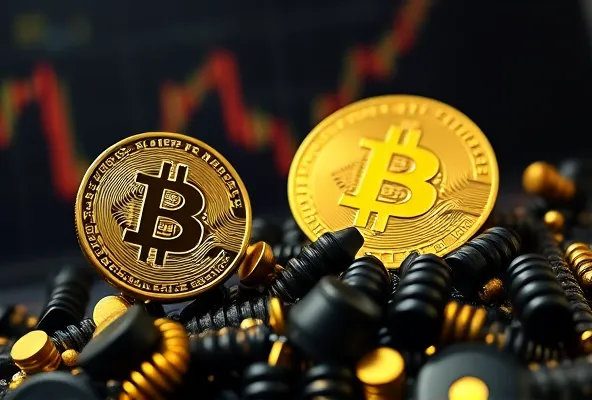A Tale of Two Assets
Imagine a family gathering where two generations are debating investments. Sarah’s grandfather swears by gold; it’s been his go-to investment for decades. To him, gold represents stability, security, and a hedge against inflation. Sarah, on the other hand, is a tech-savvy millennial who advocates for Bitcoin. To her, Bitcoin is digital gold—a modern solution that combines high growth potential with the same store-of-value qualities that gold has offered for centuries. This cross-generational debate isn’t unique to Sarah’s family. As more people question which asset is the best way to protect and grow wealth, Bitcoin and gold stand at the center of the conversation. But is Bitcoin really the new gold?

 Interior
Interior Exterior
Exterior Engine
Engine


In this article, we’ll explore the similarities and differences between Bitcoin and gold, the pros and cons of each, and whether Bitcoin has the potential to replace gold as a safe haven asset.

Table of Contents
- Understanding the Role of Gold in Finance
- Bitcoin’s Emergence as Digital Gold
- Comparing Gold and Bitcoin as Investment Assets
- Price Comparison of Gold and Bitcoin
- How to Buy Bitcoin and Gold: A Step-by-Step Guide
- Why Some Investors Prefer Gold and Others Prefer Bitcoin
- Conclusion: Is Bitcoin the New Gold?
1. Understanding the Role of Gold in Finance
Gold as a Safe Haven Asset
Gold has been valued for thousands of years for its beauty, scarcity, and durability. As a tangible asset, it’s been used as currency, jewelry, and most importantly, a store of value. During economic crises, wars, and periods of high inflation, people have turned to gold to preserve their wealth.
Hedge Against Inflation
Gold’s resistance to inflation is one of its most cherished qualities. Unlike fiat currency, which governments can print at will, gold’s supply is limited. As a result, when inflation rises and currency values drop, gold tends to hold its value, making it an attractive asset for wealth preservation.
Why Gold Has Stood the Test of Time
Gold’s historical resilience and universal appeal have solidified its status as a safe haven. Today, central banks, individual investors, and governments around the world hold gold as part of their reserves, trusting it to maintain value over time.
2. Bitcoin’s Emergence as Digital Gold
Bitcoin’s Introduction to the Market
Launched in 2009, Bitcoin was initially viewed as an experiment in digital currency. But as its value grew and its underlying technology, blockchain, gained recognition, Bitcoin started to attract attention as a revolutionary financial asset. Investors began to see Bitcoin as a store of value, similar to gold.
Scarcity and Decentralization
Bitcoin shares two key characteristics with gold: scarcity and decentralization. There will only ever be 21 million Bitcoins, giving it a fixed supply that’s immune to inflation. Additionally, Bitcoin operates on a decentralized network, meaning it’s not controlled by any government or central authority.
Why Bitcoin is Called “Digital Gold”
Bitcoin’s finite supply and security make it appealing to investors looking for a hedge against economic instability. Like gold, Bitcoin is viewed as a store of value rather than just a means of transaction. As more institutions and investors recognize its potential, Bitcoin is becoming known as “digital gold.”
3. Comparing Gold and Bitcoin as Investment Assets
| Feature | Gold | Bitcoin |
|---|---|---|
| Supply | Limited but can increase through new mining | Fixed at 21 million coins |
| Liquidity | Highly liquid with well-established global market | Highly liquid but with higher volatility |
| Storage | Requires physical storage (safe, vault) | Digital storage (wallets) |
| Decentralization | Centralized, with large holders (governments) | Decentralized, peer-to-peer network |
| Accessibility | Accessible but may require intermediaries | Accessible worldwide via the internet |
| Transaction Speed | Can be slow and involves physical transfer | Fast digital transfers |
| Regulation | Highly regulated and traditional | Growing regulation but still largely independent |
| Volatility | Historically stable | High volatility |
| Inflation Hedge | Proven inflation hedge | Potential as an inflation hedge |
| Ease of Purchase | Buyable via banks, brokers, and exchanges | Buyable via cryptocurrency exchanges |
Liquidity and Volatility
Gold has a stable history with relatively low volatility, making it a safe but slow-growing investment. Bitcoin, in contrast, is highly volatile. This volatility can lead to rapid gains but also significant losses, making it appealing for high-risk investors but concerning for risk-averse ones.
Storage Needs
Gold requires physical storage, which involves security risks and costs. Bitcoin, as a digital asset, only needs a secure digital wallet. However, Bitcoin’s digital nature makes it vulnerable to hacking if not properly secured.
Transaction Efficiency
Buying or selling gold typically involves physical transfer and higher transaction costs, especially internationally. Bitcoin transactions, being digital, are fast and can be done globally with minimal fees, which makes it easier for small, frequent transactions.

4. Price Comparison of Gold and Bitcoin
Over the past decade, both gold and Bitcoin have shown significant price changes, with Bitcoin displaying much higher growth potential but also greater volatility. Below is a table comparing the average prices of gold and Bitcoin over recent years to illustrate these differences.
| Year | Average Gold Price (per ounce) | Average Bitcoin Price (per coin) |
|---|---|---|
| 2015 | $1,160 | $272 |
| 2016 | $1,250 | $570 |
| 2017 | $1,257 | $4,000 |
| 2018 | $1,269 | $7,500 |
| 2019 | $1,393 | $7,200 |
| 2020 | $1,769 | $11,100 |
| 2021 | $1,798 | $47,000 |
| 2022 | $1,800 | $40,000 |
| 2023 | $1,937 | $28,000 |
Note: Prices are approximate averages and reflect general trends.
Price Trends and Market Reactions
Bitcoin’s price has surged since its inception, significantly outpacing gold in terms of percentage growth. However, its volatility means its value can drop as quickly as it rises, unlike gold’s gradual price shifts. Gold’s steady price growth makes it a safer store of value, while Bitcoin’s rapid appreciation appeals to investors seeking high returns.
5. How to Buy Bitcoin and Gold: A Step-by-Step Guide
| Step | Buying Bitcoin | Buying Gold |
|---|---|---|
| 1. Choose Platform | Select a reputable exchange (Coinbase, Binance, Kraken) | Choose a dealer, bank, or online platform |
| 2. Create Account | Create a digital account, verify identity | Set up an account if buying online |
| 3. Fund Account | Deposit fiat currency or crypto | Deposit fiat currency |
| 4. Make Purchase | Buy Bitcoin through exchange platform | Buy gold in bars, coins, or certificates |
| 5. Store Securely | Transfer to a secure digital wallet | Store in a safe, vault, or bank storage |
| 6. Monitor Investments | Track Bitcoin market prices | Monitor gold spot prices |
6. Why Some Investors Prefer Gold and Others Prefer Bitcoin
Why Gold Still Appeals
Gold has a long history, low volatility, and proven performance as an inflation hedge. Investors who value stability, have limited risk tolerance, and prefer tangible assets may gravitate toward gold. Central banks, governments, and traditional investors often rely on gold as a dependable, secure investment.
Why Bitcoin Attracts Modern Investors
Bitcoin offers high potential growth and digital convenience. It appeals to younger generations and tech-savvy investors looking for high returns and a decentralized investment option. Bitcoin’s limited supply and ease of transaction also make it a popular choice for those seeking an alternative to traditional assets.
Combining Gold and Bitcoin
Many investors choose to balance both assets in their portfolios, using gold as a safe hedge while also taking advantage of Bitcoin’s growth potential. This balanced approach allows them to benefit from the security of gold and the potential upside of Bitcoin.
FAQ
Q1: Is Bitcoin really as safe as gold?
While Bitcoin has grown significantly, it’s highly volatile and doesn’t have the centuries-long track record of stability that gold does. Bitcoin’s safety largely depends on secure storage and a long-term investment perspective.
Q2: Can Bitcoin replace gold as an inflation hedge?
Bitcoin’s fixed supply makes it a potential inflation hedge, but it’s still new compared to gold, which has historically retained value during inflation. Many experts believe Bitcoin could complement, but not replace, gold as an inflation hedge.
Q3: Which is better for short-term investment—Bitcoin or gold?
Bitcoin has higher volatility, making it potentially lucrative for short-term gains but riskier than gold. Gold, with its stability, is better suited for long-term, low-risk investments.
Q4: Do central banks invest in Bitcoin?
While a few smaller countries have started to hold Bitcoin, most central banks still invest in gold. Bitcoin is gaining legitimacy, but central banks are cautious due to regulatory and volatility concerns.
Q5: How much should I allocate to Bitcoin versus gold?
Investment allocations vary by risk tolerance and financial goals. Many recommend 1-5% of a portfolio for Bitcoin due to its high growth potential, while gold allocations tend to be higher for stability.
Conclusion: Is Bitcoin the New Gold?
Bitcoin and gold each offer unique advantages. Gold’s historical resilience, low volatility, and universal acceptance make it a trusted safe haven. Bitcoin, with its high growth potential, ease of digital transactions, and decentralized nature, provides a new way to protect and grow wealth. While Bitcoin may not yet fully replace gold, it has emerged as a promising alternative or complement to traditional assets. For those looking to secure wealth and embrace the future of finance, a combination of Bitcoin and gold may provide the best of both worlds. As the financial landscape evolves, Bitcoin’s role as “digital gold” may only grow stronger.











